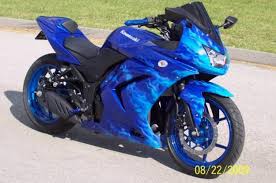Kawasaki Ninja Sport Bike~
The Kawasaki Ninja 250R (previous generations had market-specific names) is a sport motorcycle originally introduced by Kawasaki Motors in 1983. As the marque's entry-level sport bike, it has proven to be a top seller, continuously experiencing double-digit sales growth. It is a popular machine with novices and experienced riders alike, renowned for its light handling, good fuel economy, and comfortable riding posture.



In 2008, Kawasaki gave the EX250 its most thorough modernization in many years. The EX250-J model is known as the Ninja 250R worldwide, regardless of market.
Parts from the third generation are still found on the -J, but its redesigned exterior panels bring the smallest Ninja's appearance out of the '90s and into line with late-2000s sportbikes. The engine and drive train retain 30% of the -F model's parts, according to Kawasaki. The engine's compression and maximum torque have been lowered to provide better midrange performance, where the motorcycle spends most of its time. The redesign of the engine was a response to frustration felt by new riders, according to Kawasaki, resulting in improvements in engine response at low RPM, and making the bike smoother and "much easier to ride." Though the previous generation Ninja 250 had a peak power of 1 horsepower (0.75 kW) more, or peak engine power of 5 horsepower (3.7 kW) more according to official Kawasaki specifications, according to testing by Motorcycle Consumer News, the new version's 20 or 30 percent increase in mid-range power allows the bike to pull from 3,000 rpm where previously it had to be revved to 4,000. The U.S. -J model uses dual carburetors like the -F model, but the European, Brazilian and Thai models have fuel-injection. The wheels were increased in size to 17 inches, the front suspension was beefed up, and the brake rotors were replaced with a larger petal shape. A on the carbureted version, a fuel gauge was added in place of the temperature gauge. With the additional and redesigned equipment, the EX250-J suffered a 10 kg (22 lb) increase in wet weight over its predecessors.
No comments:
Post a Comment